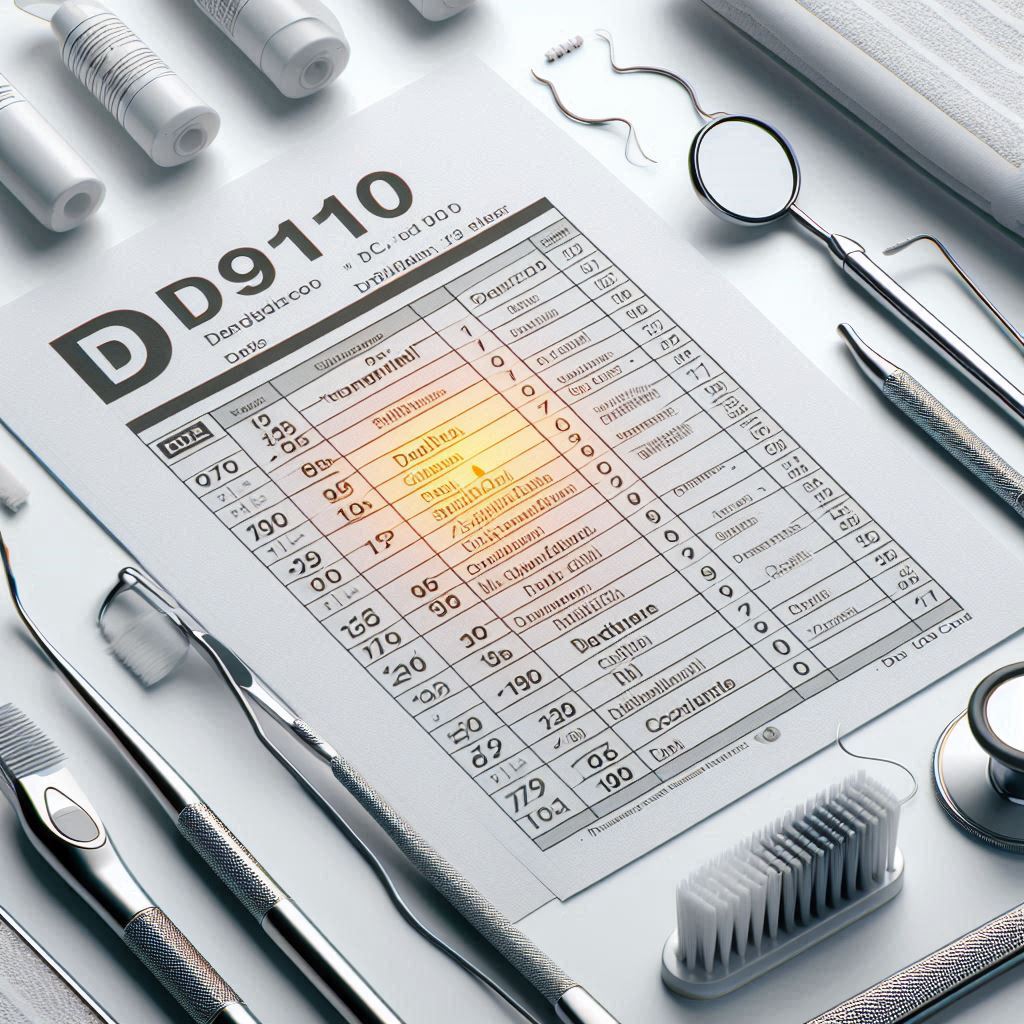D9110 Dental Code Antibiotic
The D9110 dental code is a specific billing code used in dentistry to denote palliative treatment of dental pain. This code is often associated with procedures that alleviate pain or discomfort, including the use of antibiotics to manage infections. Antibiotics play a critical role in dental care, particularly when treating bacterial infections that can arise from conditions such as abscesses, periodontal disease, or post-surgical complications.
Antibiotic treatment under the D9110 code is not a standalone procedure but is often part of a broader treatment plan. For example, a patient presenting with a severe toothache caused by an abscess may receive antibiotics to control the infection before undergoing a root canal or extraction. The use of antibiotics in dentistry must be carefully managed to avoid overuse, which can contribute to antibiotic resistance.
Dentists must consider several factors when prescribing antibiotics, including the type of infection, the patient’s medical history, and potential drug interactions. The goal is to provide effective treatment while minimizing risks to the patient and public health.

D9110 Dental Code Antibiotic List
When it comes to dental infections, not all antibiotics are created equal. The choice of antibiotic depends on the type of bacteria causing the infection, the severity of the condition, and the patient’s allergies or sensitivities. Below is a list of commonly prescribed antibiotics in dentistry:
- Amoxicillin: A broad-spectrum penicillin antibiotic, amoxicillin is often the first line of defense against dental infections. It is effective against a wide range of bacteria and is generally well-tolerated.
- Clindamycin: For patients allergic to penicillin, clindamycin is a popular alternative. It is particularly effective against anaerobic bacteria, which are often involved in dental abscesses.
- Metronidazole: This antibiotic is often used in combination with amoxicillin to treat severe infections, especially those involving anaerobic bacteria.
- Azithromycin: A macrolide antibiotic, azithromycin is used for patients who cannot tolerate penicillin or clindamycin. It has a long half-life, allowing for once-daily dosing.
- Cephalexin: A cephalosporin antibiotic, cephalexin is another alternative for penicillin-allergic patients. It is effective against many gram-positive bacteria.
Each antibiotic has its own indications, contraindications, and side effects. Dentists must carefully evaluate the patient’s condition before making a selection.
D9110 Dental Code Antibiotic Chart
To help dentists and patients understand the appropriate use of antibiotics, the following chart outlines common antibiotics, their dosages, and indications:
| Antibiotic | Dosage | Indications | Contraindications |
|---|---|---|---|
| Amoxicillin | 500 mg every 8 hours | Dental abscesses, periodontal infections | Penicillin allergy |
| Clindamycin | 300 mg every 6 hours | Penicillin allergy, anaerobic infections | History of colitis |
| Metronidazole | 500 mg every 8 hours | Severe anaerobic infections | Alcohol use, pregnancy |
| Azithromycin | 500 mg once daily | Penicillin allergy, mild infections | Liver disease |
| Cephalexin | 500 mg every 6 hours | Penicillin allergy, gram-positive infections | Severe penicillin allergy |
This chart serves as a quick reference guide but should not replace professional judgment. Dentists must tailor treatment to the individual patient.
D9110 Dental Code Antibiotic Resistance
Antibiotic resistance is a growing concern in dentistry and medicine as a whole. Overuse or misuse of antibiotics can lead to the development of resistant bacterial strains, making infections harder to treat. In dentistry, the risk of resistance is particularly high due to the frequent use of antibiotics for prophylactic and therapeutic purposes.
To combat antibiotic resistance, dentists must adhere to evidence-based guidelines. For example, antibiotics should not be prescribed for viral infections or mild bacterial infections that the immune system can handle. Additionally, dentists should educate patients about the importance of completing their antibiotic course as prescribed, even if symptoms improve.
Public health initiatives, such as antibiotic stewardship programs, are also essential in reducing resistance. These programs promote the responsible use of antibiotics and encourage the development of new treatments.
D9110 Dental Code Antibiotic Dosage
Proper dosing is critical to the success of antibiotic treatment. Underdosing can lead to treatment failure and resistance, while overdosing increases the risk of side effects. The dosage depends on factors such as the patient’s age, weight, and kidney function.
For example, the typical dosage of amoxicillin for an adult with a dental infection is 500 mg every 8 hours for 7-10 days. For children, the dosage is based on weight, usually 20-40 mg/kg per day divided into three doses. Dentists must adjust dosages for patients with renal impairment or other medical conditions.
D9110 Dental Code Antibiotic Guide
To ensure the safe and effective use of antibiotics in dentistry, follow this step-by-step guide:
- Assess the Patient: Determine the cause of the infection and whether antibiotics are necessary.
- Select the Appropriate Antibiotic: Choose an antibiotic based on the type of infection and the patient’s medical history.
- Prescribe the Correct Dosage: Tailor the dosage to the patient’s needs.
- Educate the Patient: Explain the importance of completing the course and potential side effects.
- Monitor the Patient: Follow up to ensure the infection is resolving and address any adverse reactions.
Conclusion
The D9110 dental code encompasses palliative treatments, including the use of antibiotics to manage dental infections. By understanding the appropriate antibiotics, dosages, and resistance risks, dentists can provide effective care while safeguarding public health.
FAQs
1. What is the D9110 dental code?
The D9110 code is used for palliative treatment of dental pain, including the use of antibiotics to manage infections.
2. Can antibiotics cure a tooth infection?
Antibiotics can control bacterial infections but are often used in conjunction with other treatments, such as root canals or extractions.
3. What are the risks of antibiotic resistance?
Overuse of antibiotics can lead to resistant bacteria, making infections harder to treat and posing a public health risk.


